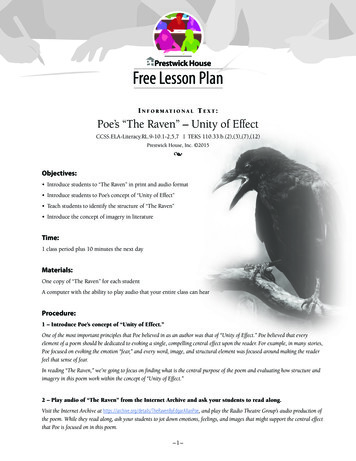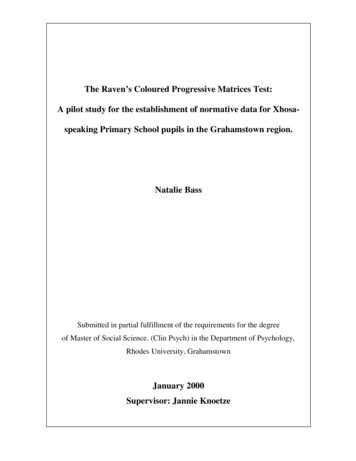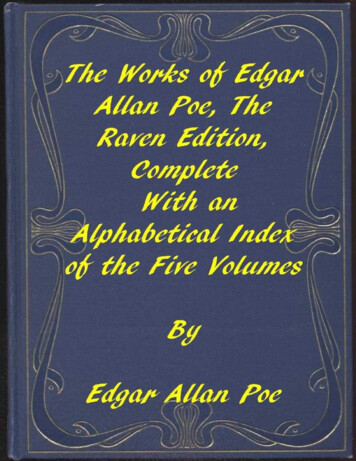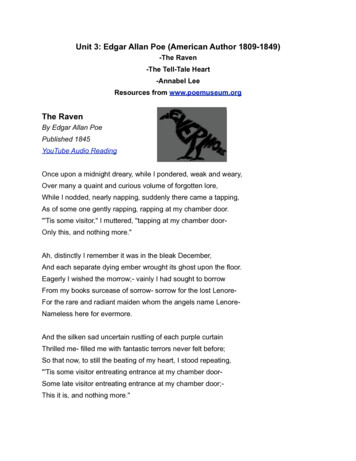
Transcription
Free Lesson PlanI n f o r m at i o n a l T e x t :Poe’s “The Raven” – Unity of EffectCCSS.ELA-Literacy.RL.9-10.1-2,5,7 TEKS 110.33.b.(2),(3),(7),(12)Prestwick House, Inc. 2015 Objectives: Introduce students to “The Raven” in print and audio format Introduce students to Poe’s concept of “Unity of Effect” Teach students to identify the structure of “The Raven” Introduce the concept of imagery in literatureTime:1 class period plus 10 minutes the next dayMaterials:One copy of “The Raven” for each studentA computer with the ability to play audio that your entire class can hearProcedure:1 – Introduce Poe’s concept of “Unity of Effect.”One of the most important principles that Poe believed in as an author was that of “Unity of Effect.” Poe believed that everyelement of a poem should be dedicated to evoking a single, compelling central effect upon the reader. For example, in many stories,Poe focused on evoking the emotion “fear,” and every word, image, and structural element was focused around making the readerfeel that sense of fear.In reading “The Raven,” we’re going to focus on finding what is the central purpose of the poem and evaluating how structure andimagery in this poem work within the concept of “Unity of Effect.”2 – Play audio of “The Raven” from the Internet Archive and ask your students to read along.Visit the Internet Archive at e, and play the Radio Theatre Group’s audio production ofthe poem. While they read along, ask your students to jot down emotions, feelings, and images that might support the central effectthat Poe is focused on in this poem.–1–
I n f o r m at i o n a l T e x t :Poe’s “The Raven” – Unity of EffectCCSS.ELA-Literacy.RL.9-10.1-2,5,7 TEKS 110.33.b.(2),(3),(7),(12)Prestwick House, Inc. 2015 3 – Discuss the central emotional effect that this poem is focused on.Begin by making sure that your students understand the basic events of the poem by leading a discussion of who the narrator is, whathappens during the poem, and what various allusions refer to.Once you’re convinced that your class has an understanding of the basic events in the poem, direct the discussion toward the centralemotional effect that this poem revolves around.Ask your students to share any emotions that this poem arouses. As they suggest various emotions, write them on the board.Once you’ve gathered a list of emotions, see how your class’s list compares with what Poe wrote about his intentions in his 1846 article,“The Philosophy of Composition.”“Regarding, then, Beauty as my province, my next question referred to the tone of its highest manifestation—and all experience has shown that this tone is one of sadness. Beauty of whatever kind, in its supreme development, invariably excitesthe sensitive soul to tears. Melancholy is thus the most legitimate of all the poetical tones.”4 – Begin examining the structure of the poem by looking at the rhyme scheme.Looking at the poem as a whole, you see that the basic structure of the poem is made up of 18 stanzas that each follow the same format.To start your review of the structure, take a look at the rhyme scheme. Ask your students to identify how the poem rhymes. Each stanzahas 3 separate rhymes. The first and third lines have an internal rhyme in which the 8th and final syllables rhyme. The remaining linesall rhyme—not only within the stanza, but between stanzas as well.Once upon a midnight dreary, while I pondered, weak and weary,Over many a quaint and curious volume of forgotten lore—While I nodded, nearly napping, suddenly there came a tapping,As of some one gently rapping, rapping at my chamber door—“’Tis some visitor,” I muttered, “tapping at my chamber door—Only this and nothing more.”5 – Continue your analysis of the poem, but looking at the rhythmic structure.Begin by asking your students to count the syllables in the first line of the poem. That line has 16 syllables. Then, help your studentsidentify the stressed and unstressed syllables in that line. By exaggerating the level of stress by reading the bolded syllables loudly andthe unbolded syllables quietly, your students should be able to identify the pattern.Once u-pon a mid-night drea-ry, while I pon-dered, weak and wea-ry,The pattern is a series of alternating stressed and unstressed syllables. Each of those pairs of syllables or “metrical feet” is called atrochee, and because there are 8 of them, the meter is called trochaic octameter.Take a look at the second line, and ask your students if they can identify what’s different between this line and the previous line. If theylook carefully, they’ll notice that the line is only 15 syllables. It’s missing the final syllable. They’ll also quickly notice that the final line isonly 7 syllables long.–2–
I n f o r m at i o n a l T e x t :Poe’s “The Raven” – Unity of EffectCCSS.ELA-Literacy.RL.9-10.1-2,5,7 TEKS 110.33.b.(2),(3),(7),(12)Prestwick House, Inc. 2015 Once upon a midnight dreary, while I pondered, weak and weary,Over many a quaint and curious volume of forgotten lore—While I nodded, nearly napping, suddenly there came a tapping,As of some one gently rapping, rapping at my chamber door—“’Tis some visitor,” I muttered, “tapping at my chamber door—Only this and nothing more.”6 – Discuss some potential reasons behind the author’s choices in crafting a poem using this structure.Once you look at what an author has done in developing the structure of a poem, the next step is to make guesses as to why he or shemade these decisions. In this case, the author’s deviating from the structure that he establishes in the first line draws attention to the endof the second, fourth, and fifth lines. When you read the stanzas aloud, the unstressed syllable that’s missing from the end of the linegives the reader a brief pause. Listen to the first stanza again, and note how the reader gives a slightly extended pause at the end of eachof those lines. This emphasizes the rhyme at the end of the lines that rhyme with “door.”When you reach the final line of the stanza, you’re interrupted only halfway through the line. Leading to an even longer pause and putting great emphasis on that line. If you review the entire poem, you’ll see that most of those final lines end with a variation on “nothingmore” or “nevermore.” This repetition emphasizes the feeling of loss, which is the central idea of the poem.7 – Discuss the concept of imagery.In literature, imagery doesn’t refer just to items in a work that are described visually, but also to descriptions that are designed to appealto any of our senses. Some of the most evocative imagery in literature is aided by figures of speech such as similes or metaphors.In the first stanza, the author appeals to our senses with descriptions of “midnight dreary” and the onomatopoeia of the sound of “rapping” and “tapping” on the door. For homework tonight, reread the poem, paying careful attention to the imagery used throughout it.Highlight or underline at least 10 different images that evoke at least 3 different senses.8 – Review the examples of imagery that your students found in the text.Ask your students to share examples from the text. Write each example on the board. Once you have 8 to 10 examples, discuss howeach image relates to the central concept of loss.9 – Wrap up your unit with a discussion of the concept of “Unity of Effect.”When Poe composed “The Raven,” he started from a statement of purpose—to capture a specific feeling and focus on expressing it.From the selection of the poem’s structure to the selection of words and images, every element leads to that singular goal.This focus is what he called “Unity of Effect” and is the reason this poem is still so powerfully received more than 170 years since it wasfirst published.–3–
Free Lesson PlanI n f o r m at i o n a l T e x t :Poe’s “The Raven” – Unity of EffectCCSS.ELA-Literacy.RL.9-10.1-2,5,7 TEKS 110.33.b.(2),(3),(7),(12)Prestwick House, Inc. 2015 MaterialsHandout:“The Raven” by Edgar Allan Poe. 5Standards and References. 9Contact Information. 9–4–
I n f o r m at i o n a l T e x t :Poe’s “The Raven” – Unity of EffectCCSS.ELA-Literacy.RL.9-10.1-2,5,7 TEKS 110.33.b.(2),(3),(7),(12)Prestwick House, Inc. 2015 “The Raven” by Edgar Allan PoeOnce upon a midnight dreary, while I pondered, weak and weary,Over many a quaint and curious volume of forgotten lore,While I nodded, nearly napping, suddenly there came a tapping,As of some one gently rapping, rapping at my chamber door.“’Tis some visitor,” I muttered, “tapping at my chamber door—Only this, and nothing more.”Ah, distinctly I remember it was in the bleak December,And each separate dying ember wrought its ghost upon the floor.Eagerly I wished the morrow;—vainly I had sought to borrowFrom my books surcease of sorrow—sorrow for the lost Lenore—For the rare and radiant maiden whom the angels name Lenore—Nameless here for evermore.And the silken sad uncertain rustling of each purple curtainThrilled me—filled me with fantastic terrors never felt before;So that now, to still the beating of my heart, I stood repeating,“’Tis some visitor entreating entrance at my chamber door—Some late visitor entreating entrance at my chamber door;—This it is, and nothing more.”Presently my soul grew stronger; hesitating then no longer,“Sir,” said I, “or Madam, truly your forgiveness I implore;But the fact is I was napping, and so gently you came rapping,And so faintly you came tapping, tapping at my chamber door,That I scarce was sure I heard you”—here I opened wide the door;—Darkness there, and nothing more.Deep into that darkness peering, long I stood there wondering, fearing,Doubting, dreaming dreams no mortals ever dared to dream before;But the silence was unbroken, and the stillness gave no token,And the only word there spoken was the whispered word, “Lenore?”This I whispered, and an echo murmured back the word, “Lenore!”—Merely this, and nothing more.–5–
I n f o r m at i o n a l T e x t :Poe’s “The Raven” – Unity of EffectCCSS.ELA-Literacy.RL.9-10.1-2,5,7 TEKS 110.33.b.(2),(3),(7),(12)Prestwick House, Inc. 2015 Back into the chamber turning, all my soul within me burning,Soon again I heard a tapping somewhat louder than before.“Surely,” said I, “surely that is something at my window lattice;Let me see, then, what thereat is, and this mystery explore—Let my heart be still a moment and this mystery explore;—’Tis the wind and nothing more!”Open here I flung the shutter, when, with many a flirt and flutter,In there stepped a stately Raven of the saintly days of yore.Not the least obeisance made he; not a minute stopped or stayed he;But, with mien of lord or lady, perched above my chamber door—Perched upon a bust of Pallas just above my chamber door—Perched, and sat, and nothing more.Then this ebony bird beguiling my sad fancy into smiling,By the grave and stern decorum of the countenance it wore.“Though thy crest be shorn and shaven, thou,” I said, “art sure no craven,Ghastly grim and ancient Raven wandering from the Nightly shore—Tell me what thy lordly name is on the Night’s Plutonian shore!”Quoth the Raven, “Nevermore.”Much I marvelled this ungainly fowl to hear discourse so plainly,Though its answer little meaning—little relevancy bore;For we cannot help agreeing that no living human beingEver yet was blest with seeing bird above his chamber door—Bird or beast upon the sculptured bust above his chamber door,With such name as “Nevermore.”But the Raven, sitting lonely on the placid bust, spoke onlyThat one word, as if his soul in that one word he did outpour.Nothing further then he uttered—not a feather then he fluttered—Till I scarcely more than muttered, “Other friends have flown before—On the morrow he will leave me, as my Hopes have flown before.”Then the bird said, “Nevermore.”–6–
I n f o r m at i o n a l T e x t :Poe’s “The Raven” – Unity of EffectCCSS.ELA-Literacy.RL.9-10.1-2,5,7 TEKS 110.33.b.(2),(3),(7),(12)Prestwick House, Inc. 2015 Startled at the stillness broken by reply so aptly spoken,“Doubtless,” said I, “what it utters is its only stock and store,Caught from some unhappy master whom unmerciful DisasterFollowed fast and followed faster till his songs one burden bore—Till the dirges of his Hope that melancholy burden bore,Of ‘Never—nevermore’.”But the Raven still beguiling my sad fancy into smiling,Straight I wheeled a cushioned seat in front of bird and bust and door;Then, upon the velvet sinking, I betook myself to linkingFancy unto fancy, thinking what this ominous bird of yore—What this grim, ungainly, ghastly, gaunt, and ominous bird of yoreMeant in croaking “Nevermore.”This I sat engaged in guessing, but no syllable expressingTo the fowl whose fiery eyes now burned into my bosom’s core;This and more I sat divining, with my head at ease recliningOn the cushion’s velvet lining that the lamplight gloated o’er,But whose velvet violet lining with the lamplight gloating o’er,She shall press, ah, nevermore!Then, methought, the air grew denser, perfumed from an unseen censerSwung by Seraphim whose footfalls tinkled on the tufted floor.“Wretch,” I cried, “thy God hath lent thee—by these angels he hath sent theeRespite—respite and nepenthe, from thy memories of Lenore;Quaff, oh quaff this kind nepenthe and forget this lost Lenore!”Quoth the Raven, “Nevermore.”“Prophet!” said I, “thing of evil!—prophet still, if bird or devil!—Whether Tempter sent, or whether tempest tossed thee here ashore,Desolate yet all undaunted, on this desert land enchanted—On this home by Horror haunted—tell me truly, I implore—Is there—is there balm in Gilead?—tell me—tell me, I implore!”Quoth the Raven, “Nevermore.”–7–
I n f o r m at i o n a l T e x t :Poe’s “The Raven” – Unity of EffectCCSS.ELA-Literacy.RL.9-10.1-2,5,7 TEKS 110.33.b.(2),(3),(7),(12)Prestwick House, Inc. 2015 “Prophet!” said I, “thing of evil!—prophet still, if bird or devil!By that Heaven that bends above us—by that God we both adore—Tell this soul with sorrow laden if, within the distant Aidenn,It shall clasp a sainted maiden whom the angels name Lenore—Clasp a rare and radiant maiden whom the angels name Lenore.”Quoth the Raven, “Nevermore.”“Be that word our sign in parting, bird or fiend!” I shrieked, upstarting—“Get thee back into the tempest and the Night’s Plutonian shore!Leave no black plume as a token of that lie thy soul hath spoken!Leave my loneliness unbroken!—quit the bust above my door!Take thy beak from out my heart, and take thy form from off my door!”Quoth the Raven, “Nevermore.”And the Raven, never flitting, still is sitting, still is sittingOn the pallid bust of Pallas just above my chamber door;And his eyes have all the seeming of a demon’s that is dreaming,And the lamplight o’er him streaming throws his shadow on the floor;And my soul from out that shadow that lies floating on the floorShall be lifted—nevermore!–8–
I n f o r m at i o n a l T e x t :Poe’s “The Raven” – Unity of EffectCCSS.ELA-Literacy.RL.9-10.1-2,5,7 TEKS 110.33.b.(2),(3),(7),(12)Prestwick House, Inc. 2015 Common Core Standards – Reading: -10.1levelReading Literature: Fiction, Poetry, and Exercises Based on the Common Core State StandardsStandards:Fiction, Poetry, and ExercisesBased on the Common CoreState Standards9ReadingLiterature:Fiction, Poetry, and ExercisesBased on the Common CoreState -Literacy.RL.9-10.5level 9P.O. Box 658Clayton, DE 199381 (800) 0.7Printed in the U.S.A.Texas Essential Knowledge and Skillscby Edgar Allan PoeTEKS 110.33.b.(3)TEKS 110.33.b.(7)Edgar Allan Poedgar aLLan Poe—his name conjures up thoughts of hearts beating long aftertheir owners are dead, of disease and plague amid wealth, of love that extendsbeyond the grave, and of black ravens who utter only one word. The richness ofPoe’s writing, however, includes much more than horror, loss, and death.Alive with hypnotic sounds and mesmerizing rhythms, his poetry captures boththe splendor and devastation of love, life, and death. His stories teem with ironyand black humor, in addition to plot twists and surprise endings. Living by theirown rules and charged with passion, Poe’s characters are instantly recognizable—even though we may be appalled by their actions, we understand their motivations.The thirty-three selections in The Best of Poe highlight his unique qualities.Discover for yourself the mysterious allure and genius of Edgar Allan Poe, whoremains one of America’s most popular and important authors, even more than150 years after his death.by Edgar Allan PoeLWe hope that Prestwick House Literary Touchstone Classics will make yourreading more enjoyable and more meaningful. Additional information on thisanthology and other classics in this series can be seen at www.prestwickhouse.com.To purchase Downloadable Prestwick House Teaching Units , Activity Packs ,or other resources for this book, visit:The Tell-Tale Heart, The Raven,The Cask of Amontillado, and 30 Othersi t e r a r yeTheBest of PoetThe Tell-Tale Heart, The Raven,The Cask of Amontillado, and 30 Otherso u c H s t o n eThe BesT of PoeTheBesT of PoeTEKS 110.33.b.(2)L a s s i c sItem No. 309612TEKS 110.33.b.(12)o u s ewww.prestwickhouse.com References:Printed in the U.S.A.PCover Designby Jen MendozaPrestwick House Literary Touchstone ClassicsLITERARY TOUCHSTONE CLASSICS P.O. Box 658 Clayton, Delaware 19938 www.prestwickhouse.comItem No. 204866r e s t w i c kHCall 1(800) 932-4593 for a complete catalogue.unaBridgedwiThglossaryBest of Poe COVER 2015.indd 1andnoTes2/24/15 11:39 AMPoe, Edgar Allan. “Philosophy of Composition.” Graham’s American Monthly Magazine of Literature and Art,April 1846. Philadelphia, PA.Moliken, Paul (ed.). Reading Literature—Level 9. Smyrna, DE. Publisher: Prestwick House.Moliken, Paul (ed.). Best of Poe, The – Literary Touchstone Classic. Smyrna, DE. Publisher: Prestwick House.Looking for more free resources?The English Teacher’s Free Library is always updated with new,free resources to help in your classroom, including:Find out what’s new at theEnglish Teacher’s Free Library!www.prestwickhouse.com/free-libraryP.O. Box 658 Clayton, Delaware 19938 Tel: 1.800.932.4593 Fax: 1.888.718.9333 Web: www.prestwickhouse.com–9–
“The Raven” by Edgar Allan Poe O nce upon a midnight dreary, while I pondered, weak and weary, Over many a quaint and curious volume of forgotten lore, While I nodded, nearly napping, suddenly there came a tapping, As of some one gently rapping, rapping at my chamber door. “’Ti










